Cheetah Conservation Fund and Other Experts Ask for Reclassification of Cheetah from Vulnerable to Endangered Status in New Report
-

- by CCF Staff December 27, 2016
FOR IMMEDIATE RELEASE
Cheetah Conservation Fund and Other Experts Ask for Reclassification of Cheetah from Vulnerable to Endangered Status in New Report
OTJIWARONGO, NAMIBIA (27 Dec 2016) – The wild cheetah population is declining at an alarming rate, prompting conservationists to call upon the International Union for the Conservation of Nature (IUCN) to upgrade its classification of the world’s fastest mammal from vulnerable to the more serious category of endangered.
“We are sounding a loud warning cry, otherwise we may lose the species during our lifetimes”, said Dr Laurie Marker, Founder and Executive Director of Cheetah Conservation Fund (CCF) and a co-author of the report published 26 Dec. in the journal Proceedings of the National Academy of Sciences, “Disappearing spots: The global decline of cheetah and what it means for conservation”. The paper is a result of a range wide cheetah program that brought together cheetah researchers throughout the species’ remaining range to compile the best data on habitat and threats facing this iconic big cat.
An estimated 7,100 cheetahs remain scattered across Africa with a small number (approximately 50 or less) in Iran, the last of the Asian sub-species. This represents more than a 90-percent drop from 100 years ago, when the total population was estimated at 100,000. The main reason for the dramatic decline is human encroachment, change in land tenure, large scale fencing, political instability and that the protected area systems are insufficient for long-term survival, with most cheetahs living outside protected areas. According to the report, because of growing human populations, the cheetah has also lost more than of 90 percent of its historic habitat.
Cheetahs, due to their non-aggressive nature, do not fare well in wildlife reserves and other protected areas, where other predators steal their prey and kill their young. This brings cheetahs into close contact with farmers and other rural Africans, leading to increased conflict. Close to 70% of the remaining cheetah population is found outside of protected areas, with about 50% of the population found in southern African countries. These populations fall into ‘ecological traps’ as human wildlife conflict and habitat fragmentation occurs and higher extinction rates occur outside of protected areas. “For instance in Zimbabwe, an 85% decline of the population has occurred in the past 15 years due to land redistribution and politically instability”, said Marker.
“Cheetahs can reduce in numbers very drastically over a short period of time, as predators are more likely to be targeted and removed than smaller species”, said Dr Anne-Schmidt-Kuentzel, CCF’s Research Geneticist and Assistant Director of Animal Health and Research and co-author of the paper. “This fact needs to be taken into consideration when assessing the cheetah’s status”.
In order to circumvent the ramifications of small, isolated populations, a comprehensive understanding of the entire landscape where these populations occur is critical to developing an understanding of the socio-cultural demographic and economy of the communities in which they are found. This will allow for linking incentive-based approaches to assist communities along with policies and management strategies for cheetahs living outside protected areas.
To mitigate, CCF conducts farmer education and community outreach programmes and has introduced the Livestock Guarding Dog to the continent, the single most effective, non-lethal predator control tool. CCF has bred, trained and placed more than 650 of these dogs with Namibian farmers since 1994, and the organization has helped launch similar programmes in Botswanna, South Africa and Tanzania, saving hundreds of cheetah lives.
In addition to human-carnivore conflict and habitat loss, cheetahs are threatened by the illegal pet trade, where demand for cheetah cubs to become pets (predominantly from the Gulf States) drives poaching and smuggling operations in the Horn of Africa. “CCF recently led the efforts for CITES (Convention on International Trade in Endangered Species) to recognise the issues surrounding the illegal trade and poaching, and now steps are being taken to address. At the same time, we also need to look at land use changes, game fencing, and political instability, as those issues are also major factors contributing to this decline”, said Marker.
In Namibia, where CCF is based, cheetah conservation efforts are embraced by the government and the local populace. This has set the stage for the possibility of a cheetah comeback. Namibia has approximately one-third of the world’s cheetahs, earning the country its nickname, “Cheetah Capital of the World”.
For more information, contact: [email protected] or go to www.cheetah.org.
About CCF
CCF is a Namibian non-profit foundation with the goal of working with farmers on whose land the cheetah lives. CCF has grown over the past 26 years from its inception in 1990 into a world-class research, education and conservation institution that now serves as a model for other carnivore conservation programmes world-wide. CCF has made significant impact on the cheetah conservation crisis.
Some of CCF’s most important achievements include:
- Mitigating the conflict between farmers and cheetahs by introducing innovative, non-lethal predator control strategies, which include the introduction of the livestock guarding dog concept and the advancement of communal and commercial conservancies;
- Stabilising the wild cheetah population in Namibia, and helping it grow from approximately 1,500 adult cheetahs in 1990 to more than 2,500 adults today;
- Training more than 5,000 rural Namibian men and women in agriculture and land management techniques through CCF’s Future Farmers of Africa Programme, to enhance livelihoods and increase understanding of basic conservation principles;
- Impacting more than 450,000 young learners in Namibia through CCF conservation education and outreach programmes;
- Training more than 300 African biologists representing Namibia, South Sudan, Mozambique, Zambia, Algeria, Niger, Benin, Tanzania and Ethiopia in efforts to make species conservation efforts on the continent sustainable over the long term;
- Restoring thousands of hectares of wildlife habitat and farmlands in Namibia by developing an award-winning, biomass fuel product, Bushblok; and
- Creating jobs, driving the eco-tourism industry and generating an estimated 100.3 million NAD annual impact on the country’s economy.
CONTACT:
Dr Laurie Marker,
[email protected] , (0) 67 306225 or (0) 811247887
Susan Yannetti, [email protected], 202.716.7756
Related Reading


